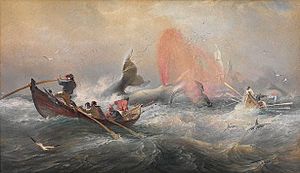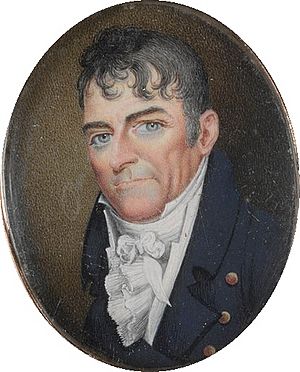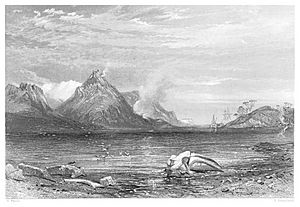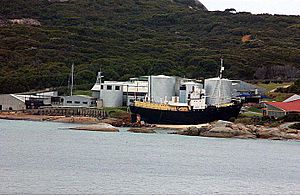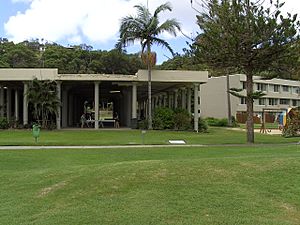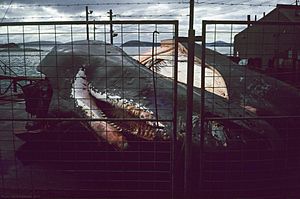Whaling in Australia facts for kids
Whaling in Australian waters started in 1791. At first, hunters mainly caught right whales and sperm whales. Later, they also hunted humpback whales, bowhead whales, and other types of whales.
Whaling grew into a huge industry in Australia. It provided jobs for many ships and thousands of people. By 1850, Australia had earned £4.2 million from selling whale products overseas.
In the 1900s, modern whaling began. This used harpoon guns and strong iron ships. Whaling stations were set up on land in Western Australia, New South Wales, and Queensland.
In 1978, the government looked closely at the whaling industry. This led to Australia stopping all whaling. The country then promised to protect whales. Today, Whale watching is a very popular activity for tourists.
Contents
Aboriginal People and Whales

Whales were important to Aboriginal people living near the coast long before Europeans arrived. For some groups in Western Australia, whales were a totem animal. This means they were a special symbol for their family or clan. Old rock art in New South Wales also shows whales were important there. Some rock carvings near Sydney show whale feasts.
Sometimes, whales would die at sea and wash up on the shore. These "drift whales" were a good source of food for coastal Aboriginal groups.
There are no records of Aboriginal people hunting whales in their small bark canoes. But some stories say they could hunt whales in other ways. For example, the Kondoli clan in South Australia was said to be able to "sing" whales closer to shore. They hoped the whales would then get stuck on the beach.
Whale bones were also useful. Ear bones were used to make drinking cups. Rib bones sometimes became the frames for gunyahs, which were simple huts.
Europeans knew about whales off Australia's coast from at least 1699. That year, a British explorer named William Dampier sailed along Western Australia. He wrote that the sea was "plentifully stocked with the largest whales that I ever saw."
When Europeans set up whaling stations on the coast in the 1800s, Aboriginal people often came to them. Some Aboriginal men worked on the whaling boats. They helped row or worked as lookouts. Their amazing eyesight helped them spot whales without needing a spyglass. A few even worked on deep-sea whaling ships from Sydney and Hobart.
Early Whaling Ships Visiting Australia
British whaling and sealing ships started visiting Sydney soon after Europeans settled there in 1788. Some ships first brought convicts or supplies. After dropping off their cargo, they would start whaling or sealing trips from Sydney Harbour.
The first ship to return to Sydney after catching whales off the coast was the Britannia. Captain Thomas Melvill commanded this ship. To celebrate, Governor Arthur Phillip gave Captain Melvill a silver cup. It was later engraved to say:
The gift of His Excellency, Arthur Phillips [sic], Esq., Captain-General and Governor-in-Chief of His Majesty's Territory of New South Wales and its Dependencies, to Thomas Melvill, Commander of the Britannia, for killing a Spermaceti Whale on the 26th October 1791. Being the first of its kind taken on this coast since the Colony was established.
Hunting sperm whales could make a lot of money. The Britannia went back to Britain in 1793. It carried 118 tuns (large barrels) of sperm whale oil and 1,900 sealskins.
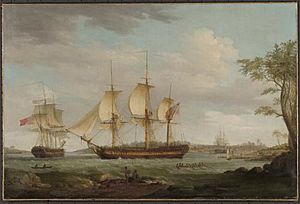
At first, there were rules that made whaling harder. The Navigation Acts and special permits gave only certain British companies the right to trade in the Pacific. But these rules slowly changed. This allowed British ships to hunt whales, seals, and trade furs without needing a special permit.
Whaling ships often carried goods or passengers on their way out. This helped them earn extra money. A ship owner named Samuel Enderby wrote in 1801 that it was very helpful for whalers to carry freight to New South Wales. His ship, Speedy, returned to London in 1801. It carried whale oil worth £13,600. Enderby said this was the most valuable cargo of its kind at that time.
Bay Whaling Stations
Bay whaling meant catching right whales in calm bays along the coasts of Australia and New Zealand. These whales came to these bays to have their babies in winter. A bay whaling station on shore needed only a few boats, large pots to boil whale blubber (called try-pots), and wooden barrels to store the oil. The whalers usually did not get a set wage. Instead, they were paid a share of what they caught, called a "lay."
When the first settlers arrived in Tasmania in 1803, they built Hobart. They soon found that the Derwent Estuary was a breeding spot for Southern Right whales. Settlers started bay whaling in the Derwent in 1805. Over the next 40 years, at least 45 whaling stations opened in Tasmania.
The first whaling station on the Australian mainland was built in 1828. Captain Thomas Raine set it up at Twofold Bay in southern New South Wales. Bay whaling also began at Portland Bay, Victoria, by 1833. It started at Encounter Bay, South Australia, in 1834, and at Doubtful Island Bay in Western Australia by 1836. Australian bay whalers also went to New Zealand. They were active at Cloudy Bay and Banks Peninsula on the South Island by 1835.
Small ships, usually schooners, would drop off teams of whalers. These teams would set up temporary camps for the winter months. The ships would then return at the end of the season to pick up the men and the full oil barrels. Some support ships stayed offshore. They served as sleeping quarters and storage for the whaling operation.
Sometimes, deep-sea whaling ships would come into the bays. They would compete with the shore-based whalers. This often happened near the end of their trip when they wanted to fill their oil barrels before going back to port. Some of these whaling stations, like those at Portland Bay and Twofold Bay, grew into permanent towns. The early settlers there combined whaling with farming.
Australian Whaling Ships
Australian-owned whaling ships first sailed from Sydney in 1805. The King George (185 tons) left Sydney in June 1805. It was hunting southern right whales in the Derwent Estuary in Tasmania by July. The first ship to hunt sperm whales was the Argo (224 tons). It left Sydney in September 1805. Australian-owned or based ships made over 1,500 whaling trips from colonial ports in the 1800s. Sydney and Hobart were the two main whaling ports.
Whaling ships were sometimes rented to move people and goods between settlements. They also helped start new colonies. The Albion (362 tons) arrived at Risdon Cove on September 8, 1803. It carried settlers who founded Hobart. The Amity (192 tons) brought the first white settlers to Western Australia in 1826. Lord Howe Island was settled by people from the Sydney whaler Caroline (192 tons) in 1834.

Whaling ships needed many crew members to man the smaller whale boats. This meant whaling was a big employer of sailors. By 1837, the 42 whaling ships based in Sydney employed about 1,300 men. Most were British-born sailors. But as years passed, more Australian-born sailors joined the fleet.
Whaling was a tough business. It created strong and skilled people. Some of them became famous in other areas. Three future politicians and a Lord Mayor of Sydney worked on Australian whalers. Others became important merchants. Whaling also influenced books in the 1800s. Henry Kendall and Herman Melville worked on Sydney whalers when they were young. They later wrote about their experiences. Kendall was a poet, and Melville wrote Omoo (1847). He is best known for Moby Dick (1851).
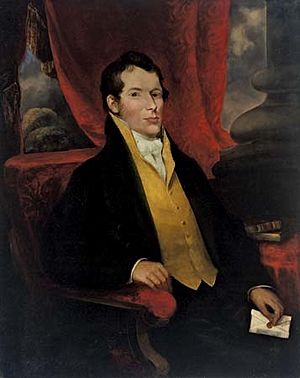
Many leading business people owned whaling ships. These included John Macarthur, Robert Campbell, Benjamin Boyd, and Robert Towns in Sydney. In Hobart, Alexander McGregor, William Crowther, Askin Morrison, and Alexander Imlay also owned whaling ships. Others helped the industry indirectly. They supplied ships with food, equipment, and services in port.
Whale oil and baleen (whalebone) from bay whalers, and sperm whale oil from deep-sea whalers, were some of Australia's first exports. Sealing and whaling brought more money to the colonies than farming until the 1830s. After that, wool production became more important.
Whaling was a very important business in colonial Australia. Between 1831 and 1845, it brought in £3.3 million from exports. The trade was strongest in the 1830s. But then it faced problems. Whale numbers went down, and a big economic downturn started in 1840. Also, gold rushes began in Australia in 1851. People also discovered that mineral oil could be made into petroleum. This new fuel replaced whale oil for lamps. Finally, people realized they could make more money from growing fine wool.
Modern Whaling Methods
Modern whaling began in the late 1800s. It used steam-powered ships and harpoon guns with explosive tips. This allowed hunters to catch larger and faster whales. Later, factory ships were built. These ships had a ramp at the back. Whales could be pulled onto the deck and processed quickly and safely. Norway was the top whaling country by the end of the 1800s. Modern whaling in Australia, like elsewhere, was linked to Norwegian business people, ships, and sailors.
A Norwegian businessman named Henrik Johan Bull lived in Australia in the 1890s. He thought of using Melbourne as a base to hunt whales in the Antarctic. He couldn't get local investors interested. So, he went back to Norway and spoke to Svend Foyn. Foyn is known as the founder of modern whaling. Bull bought a sealing ship called Cap Nor. Its engine was improved, and it was set up for whaling. Renamed Antarctic, the ship left Norway on September 20, 1893. After sealing at Kerguelen Island, it arrived in Melbourne on February 24, 1894. The Antarctic left Melbourne in April 1894. It briefly cruised off Tasmania before heading to the Auckland Islands. It returned to Melbourne five months later.
Norwegian companies built shore-based whaling stations in Western Australia. One was at Frenchman’s Bay near Albany in 1912. Another was at Point Cloates in 1913. The Australian Whaling Commission opened another station in Western Australia in 1949 at Carnarvon.
Norwegian factory ships and catcher boats sailing to and from the Antarctic would stop at Hobart. They would get supplies, pick up men, and get repairs. They also tried whaling off the coast of Tasmania. A factory ship reached Tasmania in January 1912. It took 1,599 barrels of oil off the coast. Another factory ship caught only 480 barrels of oil off Australia. But it found a huge piece of ambergris that weighed 1,003 pounds. This was the largest ever found at that time. It sold in London for £23,000.
By 1956, Australia had six whaling stations. Three were in Western Australia: Frenchman’s Bay, Point Cloates, and Carnarvon. One was at Tangalooma in Queensland. Another was at Byron Bay in New South Wales. The sixth was on Norfolk Island. Too much hunting caused the humpback whale population to crash by 1962. So, whalers started focusing on sperm whales instead.
Overfishing also led to some whaling stations closing before the government banned the industry. The whaling station at Tangalooma, Queensland, on Moreton Island, caught and processed 6,277 humpback whales between 1952 and 1962. This greatly reduced the humpback population in eastern Australia. It forced the Tangalooma, Byron Bay, and Norfolk Island whaling stations to close in 1962.
There are several places in Australia that remember the whaling industry. These include the Eden Killer Whale Museum in southern New South Wales. Also, the Cheyne Beach Whaling Station (now called Albany's Historic Whaling Station) in Western Australia. The largest collection of Australian whaling ship logbooks is kept at the W L Crowther Collection in the State Library of Tasmania.
Stopping Whaling in Australia
In 1978, the Federal Government asked Sir Sydney Frost to lead an investigation into whales and whaling. This happened after groups like Project Jonah, Friends of the Earth, and the Whale and Dolphin Coalition campaigned against whaling. They held protests in Albany, Western Australia, and across the country.
Greenpeace co-founder Bob Hunter from Canada came to Albany in August 1977. He led a protest against the three whale catcher ships working from Albany. Protesters used Zodiacs (small inflatable boats) to go 30 miles out to sea. They placed themselves between the harpoons and the whales. This was the first Greenpeace protest in Australia. Key members of the Whale and Dolphin Coalition then formed Greenpeace Australia.
On July 31, 1978, the first day of the Frost inquiry, the Cheynes Beach Whaling Company announced it would close. It would stop operations at the end of that whaling season. Cheynes Beach had been working from Frenchman Bay near Albany, Western Australia, since 1952. The very last whale, a sperm whale, was caught on November 20, 1978.
Sir Sydney's report, called Whales and Whaling: Report of the Independent Inquiry, suggested banning whaling in Australia. In April 1979, the Fraser government agreed. Australia is now a strong supporter of stopping whaling worldwide. It has strongly opposed Japan's whaling program in the Antarctic Ocean. The State Library of New South Wales has a large collection of items about whaling. These include artworks, photos, whalers' diaries, whale bone, and scrimshaw (carvings on whale bone or teeth).
Southern right whales are now returning to the Derwent River and other parts of Australia. This shows they are slowly recovering after being hunted almost to extinction.
Many people say that whale populations, especially humpbacks, have been growing steadily since whaling stopped in Australian waters. We don't know the current number of sperm whales off Western Australia. Whale watching is becoming more and more popular.
See also
 In Spanish: Caza de ballenas en Australia para niños
In Spanish: Caza de ballenas en Australia para niños
- Economic history of Australia
- Eden Killer Whale Museum
- International Whaling Commission
- Whale watching in Australia
- Whaling in Western Australia
- Cheyne Beach Whaling Station
- Benjamin Boyd
- Eber Bunker
- Robert Towns
- Whaling in the United Kingdom
- Category:Australian people in whaling, a list of captains, shipowners and others in the industry


